In the past
Famous trials
At the end of the 19th century and the beginning of the 20th, many cases impassioned public opinion and inspired artists.
The trials of Zola and Dreyfus, indissolubly associated, inspired many representations of the different actors involved: the accused, judges, lawyers, witnesses…
In other cases, it was the defendant who attracted public attention. The artists revealed their faces: Thérèse Humbert, the brain behind a huge fraud, or Marguerite Steinheil, involved in an enigmatic crime.
Image n°1 : The First Dreyfus Trial.
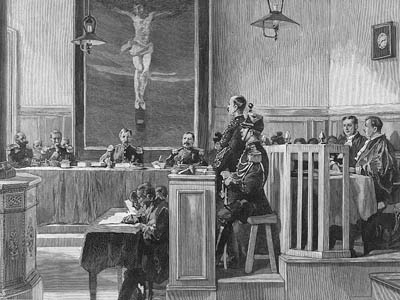
Ordre des avocats de Paris . L’Illustration. 22 décembre 1894. 22x32,5cm.
In 1894, the Dreyfus affair was only just beginning. This sketch introduced the public to the case. The accused stands in the foreground with his lawyer sitting behind. He answers the presiding judge of the council of war, who, with his assistant judges, sits in front of a huge Crucifixion, which featured in all courtrooms before the separation of the Church and the State in France. The army and religion are the dominating symbols in this solemn scene..
© Ordre des avocats de Paris
Image n°2 : Lawyer Fernand Labori pleads in Zola's defence.
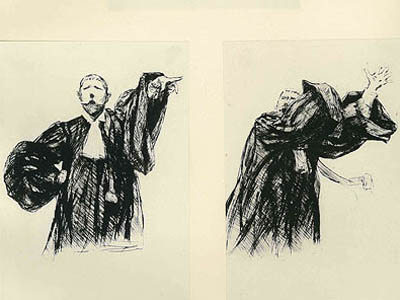
Ordre des avocats de Paris . Collection of Engravings : The Dreyfus Affair. 1898. Etchings, 49,8x34cm.
Émile Zola appeared in the Assize Court in February 1898 accused of having libellously defamed the army in his famous ‘J’accuse!’, a vibrant article written in defence of Dreyfus. One of his lawyers, Labori, attracted everyone’s attention with his fighting spirit.The artist has represented his different poses, highlighting his body language, especially his hand movements..
© Ordre des avocats de Paris
Image n°3 : The Revision of the Dreyfus trial.
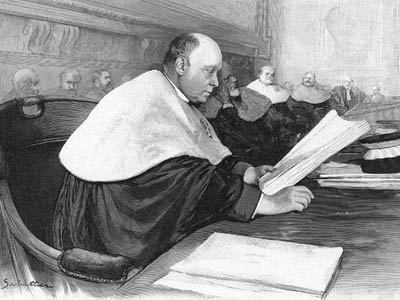
Ordre des avocats de Paris . L’Illustration. 3 juin 1899. 22x32cm.
In June 1899, the Cour de cassation decided that there should be a retrial of the Dreyfus affair.It pronounced its judgement after the presentation of a favourable report by Presiding judge Ballot-Beaupré. The artist has shown the judge reading. The orator looks confident and concentrated; his robe, trimmed with ermine – a reminder of his rank as presiding judge – stresses the authority of the person who embodies the supremacy of justice..
© Ordre des avocats de Paris
Image n°4 : The Humbert Trial.
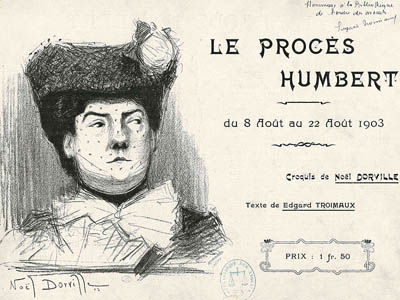
Ordre des avocats de Paris . Le Procès Humbert. 1903. 27x38cm.
For 17 years, Thérèse Humbert, whose father-in-law was a Minister of Justice and first presiding judge of the audit court, claimed she was awaiting a sizeable inheritance which was sure to be hers at the conclusion of an interminable lawsuit about the succession. She borrowed irresponsibly and frequented the cream of Parisian society. In 1902, the fraud was revealed: there was never any inheritance! The trial of ‘Grande Thérèse’ was keenly followed by all France, both scandalized and fascinated..
© Ordre des avocats de Paris
Image n°5 : The Trial of Marguerite Steinheil.
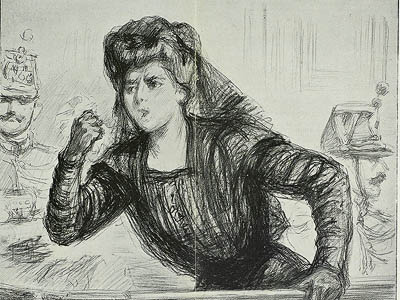
Ordre des avocats de Paris . L’Illustration. 13 novembre 1909. 41x60cm.
In 1908, Mme Steinheil was found tied up in her home, not far from her husband and her mother who had both been killed. Her incoherent statements made her a suspect and led her to the Assize court where she was found not guilty, without ever revealing the circumstances of the tragedy. Paul Renouard’s sketch is presented amid four portrait photos of the defendant, showing all her facial expressions. Taking photos during a trial was permitted until 1954..
© Ordre des avocats de Paris


